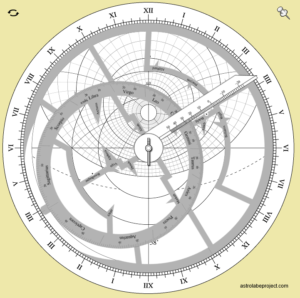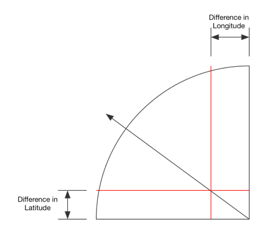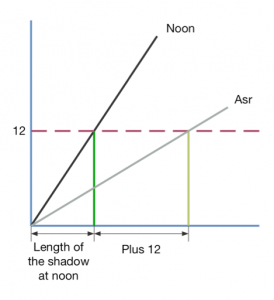Concerning the use of astrolabes as a teaching tool
- on 11.14.17
- Astrolabe Generator, Astrolabes General, Education
- Comments Off on Concerning the use of astrolabes as a teaching tool
As you can see, I’m still working at adding functionality. This release includes:
Download it HERE
Changes for 3.2:
Version 3.3 is well underway, look for it soon!
As promised more upgrades are coming. Here is the first batch.
When the using the equation of time scale option is set the alidade will have a scale printed on it. To use, just rotate the alidade to the date and read the time offset using the loop and the scale. The equation of time loop will print over any other scales and is still quite readable. You can download the 3.1 version here.
After much hard procrastination, I am happy to announce the release of version 3.0 of the Astrolabe Generator.
The old Flash version was difficult to keep improving, and is no longer working in any case. The new, downloadable version has several bugs removed, and much expanded capabilities:
The good news is that it runs on Windows, Mac, and Linux. The bad news is that some of you will have to install Java in order to run it (There is a link on the download page).
Switching back to Java will allow me to keep updating and improving the tool. and as always, I’m looking for input (see address for comments under Links). Plans for the next version include:
Download HERE.
One of the problems with learning to use an astrolabe is that in order to work through the class notes the student needs to first print out and assemble their own astrolabe from the provided materials. This takes time and materials that may not be ready to hand.
What I’ve wanted to do for a while now, was to provide an online simulator to allow the student to work without a physical copy of the device. In the past I ave played with Flash and Java, but these had significant problems with getting them to work smoothly with the Internet. Instead, I settled on HTML5 and JavaScript. Much more flexible and simple to use, and supported by all modern browsers.
There are currently two simulators available: One for the astrolabe and one for the sine quadrant. These are a work in progress and improvements are planned, but they work well as they are.
http://www.astrolabeproject.com/sim/astrolabe/sim.html
http://www.astrolabeproject.com/sim/sine/quad.html
The simulators have been tested on current versions of Internet Explorer, Firefox, Chrome, and Safari. (Note: if you are on an IPad, you can save the simulator page to your desktop and it will function like an app, still requiring an Internet connection though).
The Astrolabe Simulator
The astrolabe simulator can be found at (link). Clicking and dragging the rate rotates it, the same with the pointer arm. Clicking on the pushpin on the upper right locks the rete and arm together and allows them to be moved together. Clicking on the icon upper left flips the astrolabe to the back side.
The Sine Quadrant Simulator
The sine quadrant simulator can be found at (link). The cord can be rotated by clicking and dragging the weight on the end. The index bead (green circle) can be moved by dragging it. Function lines can be toggled on and off by clicking on the check marks bottom right.
The source code for both simulators is open source and can be downloaded here(link).
Enjoy!
For quite some time now I have been basing my class, and my discussions here, on an astrolabe with fairly basic options. Linked to the right you will find a zip file containing the components for this basic astrolabe, along with the handout for my class.
But there is more to the astrolabe than just the basic functions I have discussed so far. An examination of astrolabes from the medieval period shows a wide range of advanced function options available to the users. Over time, I have started to add some of these slowly to the Astrolabe Generator application, so that people out there can play with them. But up to now I have not spent any real time discussing of how they are used. Over the next few weeks I hope to examine several of these advanced functions.
I have rearranged the links on the left and added a new download: An Advanced Astrolabe example. This differs from the Basic example in several ways. On the front you will see new markings on the plate for the Houses of Heaven; on the back I have added a sine/cosine scale (upper left), an Arcs of the Signs scale (upper right) and the Lunar Mansions (center). In the next few posts I will discuss the purpose and use of each of these in turn.
Given that the math and sciences of the Middle East were a major driving force in the development of the astrolabe[1], it is reasonable that some of the advanced functions are related to the dominant religion of the area, Islam. Today we will discuss using two of the astrolabe’s advanced features to estimate the direction of Mecca.
For a Muslim, knowing the direction to Mecca from one’s current position is not just important because of the requirement to pray in that direction five times daily. In addition, the ritual butchering of food animals needs to be done with that direction in mind for the meat to be acceptable to the dietary laws; and when bodies are buried, they need to be placed on their sides, facing toward Mecca[2]. The specific location of the Kabaa, the focus of prayer is 21.4N 39.8E[3].
Determining this direction, known as the Qibla, is a major subject in Islamic mathematics. The Qibla is defined as being the “Great Circle” direction between a given point and the location of Mecca[4]; and there are many treatises devoted to computing it accurately. But in the case of a traveler, without access to intricate mathematics or carefully computed tables, finding the proper direction is tricky.
There are two scales to be found on the back of a typical astrolabe of the region that can help with this problem.
Estimating the Qibla using the Sine/Cosine scale
It is possible to get a rough estimate of the qibla direction by using the Sine/Cosine scale to be found on the back of many astrolabes[5]. To use this scale the user must know the latitude and longitude of Mecca, as well as their own current latitude and longitude[6].
To use the sine/cosine scale, work the problem as follows:

Example:
Finding the Qibla from Alexandria Egypt (location: 31.2N 30.0E)
The difference in latitude (rounding off) is: 10 degrees
The difference in longitude is: 10 degrees
Work the problem as below: Measure up ten degrees from the horizontal scale(1) for the difference in latitude(2), and ten degrees from the vertical scale(3) for the difference in longitude(4). Place the rotating arm on the intesection of the two imaginary lines(5) and it will point at an angle(6), 45 degrees in this case. As Mecca is east and south of Alexandria, this angle will be the angle south of due East. So add it to 90 degrees to get the compass bearing (135 degrees). Using the ruler function in Google Earth (which conveniently uses great circles) The great circle direction to Mecca is 135.68 degrees.
Determining the Qibla using the Qibla line on the arcs of the signs scale
On many astrolabes there is a scale that shows the altitude of the Sun at Noon for every day of the year. This scale is in the form of a series of ninety-degree arcs marked with the various zodiac symbols representing the location of the sun on the ecliptic. In addition to one or more curved lines representing the altitude of the Sun at noon, many of these are also marked with a set of arcs labels as major cities. These arcs can be used to determine the direction of the Qibla if the user is near one of the cities listed.
To determine the rough Qibla direction using the arcs of the signs, do as follows:
– find the Sun’s position on the zodiac using the zodiac and calendar rings of the astrolabe.
– Find the city line for the city you are near.
– Find the point on that line that is in the arc for the sun’s current zodiac position.
– Set the astrolabe’s alidade/pointer to touch this point. The alidade will point to an angle on the rim.
– When the sun is at this angle above the horizon, it will sit directly above the Qibla direction.
Example: Find the direction to Mecca from near Bagdhad Given the date is the Spring Equinox (March 20th).
Limitations
Clever as these techniques are, they are limited in usefulness. As the Qibla is a great circle line between points on the globe, the further you are from Mecca, the more inaccurate the estimate found by the first method will be. For example in the city of Casablanca (location:33.5N 7.5W) the Qibla direction is about 93.5 degrees but if you estimate it using the sine/cosine scale you get a direction of 106 degrees.
The second, arcs of signs, method is similarly limited. It does provide the great-circle direction, but because the sun has to be up and in the direction of Mecca to work, it is pretty much limited to locations within 90 degrees of Mecca.
Notes:
[1]Morrison, James E., The Astrolabe, Janus, 2007, pg. 31
[2]King, David A. and Lorch, Richard P., “Qibla Charts, Qibla Maps, and Related Instruments”. The History of Cartography, Volume 2, Book 2: Cartography in the Traditional East and Southeast Asian Societies, University Of Chicago Press, 1995. pg 198.
[3]http://en.wikipedia.org/wiki/Kaaba
[4]http://en.wikipedia.org/wiki/Qibla
[5]This technique also works on the sine quadrant, of course.
[6]King, David A., World Maps for Finding the Direction and Distance to Mecca: Innovation and Tradition in Islamic Science, Brill:1999, pp 57-60
Links
The previous installments in this series can be found here:
Part One
Part Two
Part Three
Part Four
Part Five
Printable example Sine Quadrant
In the last 5 installments we have broken down the various parts and functions of the sine quadrant. I’ve now come to the end of what I currently know. So here are some references if you wish to dig deeper.
But first some questions I still have:
Extant Sine Quadrants Online
http://en.wikipedia.org/wiki/Sine_quadrant
This is the Wikipedia entry for the Sine Quadrant. Not much information is available concerning the example in the pictures, but note that the Asr arc appears to be a later, and crudely done addition.
http://brunelleschi.imss.fi.it/galileopalazzostrozzi/object/TobiasVolckmerQuadrant.html
— This is a European variant. Note that this one has scales divided into 90 units as opposed to the usual 60. Note also the vernier scale on the degree arc. This allows for increased precision in measuring angles
http://iin-aina.blogspot.com/2011/04/nemu-kuadran-terbesar.html
— A quadrant of unusual size…
http://blogs.unpad.ac.id/kkltaringgultengah/sosial-budaya-desa-taringgul-tengah/
http://blogs.unpad.ac.id/kkltaringgultengah/files/2012/02/oo-1024×681.jpg
— A nice example of a wooden sine quadrant, the scales outside the degree scale show the zodiac and are for determining the position of the sun for finding the Solar declination.
http://www.mhs.ox.ac.uk/collections/search/displayrecord/?mode=displaymixed&module=ecatalogue&invnumber=48133&irn=1331&query=
http://www.mhs.ox.ac.uk/collections/imu-search-page/record-details/?TitInventoryNo=16856&querytype=field&thumbnails=on&irn=8355
http://www.mhs.ox.ac.uk/collections/imu-search-page/record-details/?TitInventoryNo=36052&querytype=field&thumbnails=on&irn=3334
http://www.mhs.ox.ac.uk/collections/imu-search-page/record-details/?thumbnails=on&irn=8351&TitInventoryNo=15598
http://www.mhs.ox.ac.uk/collections/imu-search-page/record-details/?thumbnails=on&irn=7066&TitInventoryNo=42166
http://www.mhs.ox.ac.uk/collections/imu-search-page/record-details/?thumbnails=on&irn=7083&TitInventoryNo=35285
http://www.mhs.ox.ac.uk/collections/imu-search-page/record-details/?thumbnails=on&irn=7465&TitInventoryNo=28781
http://www.mhs.ox.ac.uk/collections/imu-search-page/record-details/?thumbnails=on&irn=3343&TitInventoryNo=35612
http://www.mhs.ox.ac.uk/collections/imu-search-page/record-details/?thumbnails=on&irn=8350&TitInventoryNo=32534
http://www.britishmuseum.org/research/collection_online/collection_object_details.aspx?objectId=178957&partId=1&searchText=quadrant&images=true&page=2
http://www.mhs.ox.ac.uk/epact/catalogue.php?ENumber=35728&Level=
http://www.mhs.ox.ac.uk/epact/catalogue.php?ENumber=96841&Level=
http://www.mhs.ox.ac.uk/epact/catalogue.php?ENumber=94421&Level=
http://www.mhs.ox.ac.uk/scienceislam/objects.php?invnum=35285
http://collections.rmg.co.uk/collections/objects/43268.html
http://collections.rmg.co.uk/collections/objects/43269.html
http://collections.rmg.co.uk/collections/objects/43256.html
References
Bir, Atilla. (2008). Principle and Use of Ottoman Sundials. Retrieved from http://www.muslimheritage.com/topics/default.cfm?ArticleID=942
Charette, François, Mathematical Instrumentation in Fourteenth-Century Egypt and Syria. The Illustrated Treatise of Najm al-Din al-Misri, Brill, Leiden (2003).
Morley, William H., Description of an Arabic Quadrant, Journal of the Royal Asiatic Society of Great Britain and Ireland, Vol 17 (1860), pp. 322-330
In part four we examined the Asr lines and how to use them to find the proper times for the start and end of the Asr prayer required of all Moslems. This week we are going to look at an alternate method of determining that by examining yet another of the sine quadrant’s advanced functions.
Links
The previous installments in this series can be found here:
Part One
Part Two
Part Three
Part Four
Printable example Sine Quadrant
The Other Asr Lines
The two arcs described in the last part of this series are one method of determining the times for the midafternoon Asr prayer, but there are alternative methods. Some sine quadrants do not have the arcs, but rely on a different set of markings. Depending on the maker, devices will have one set of markings or the other, or both, or none.
If you look at the example sine quadrant pictured above, you will see, in addition to the previously discussed Asr arcs, two lines of markings (marked in red dots) parallel to the horizontal and vertical scales at 7 and 12 units respectively.

Traditionally the markings at 12 units are most often seen, but I have seen several examples with the additional markings at 7 units. It does not matter which set are used, as the answer they give is the same. For clarity, I will concentrate on the 12 unit line, but the steps I describe work just as well for the 7 unit line.
As was discussed in part four, the time for the start and end of the Asr prayer are defined by the length of a shadow: The period for Asr begins when the shadow of a vertical pole is equal to its noontime length plus the length of the pole; and ends when the shadow is the noontime length plus twice the length of the pole[1].
The vertical line at 12 units can be used to simulate a pole 12 units high[2]. By marking where the cord crosses the line when it is set to the Sun’s noon angle you know the length of the shadow at noon. Then by adding 12 units and moving the cord to cross at that point, you can compute the angle of the Sun at the start of Asr.
To demonstrate that using the Asr arc and the Asr line both give the same answer, let’s work through an example where the Sun is at a height of 50 degrees at local noon.
First set the cord of the quadrant on the 50 degree mark (A). Note where it crosses the Asr arc at (B), and follow that line down to find an angle of 28.5 degrees. Now notice where the cord crosses the 12 unit Asr line at 10 units (C). add 12 units to this (the “height” of the “pole”), to get 22 (D) and move the cord to cross at this point. The cord will lie at the expected angle, 28.5 degrees (E).
To find the angle of the Sun at the end of Asr, you just need to add an additional 12 units to simulate adding twice the length of the pole.
Notes:
[1]Bir, Atilla. (2008). Principle and Use of Ottoman Sundials. Retrieved from http://www.muslimheritage.com/topics/default.cfm?ArticleID=942
[2]Charette, François, Mathematical Instrumentation in Fourteenth-Century Egypt and Syria. The Illustrated Treatise of Najm al-Din al-Misri, Brill, Leiden (2003). Pg 176-177